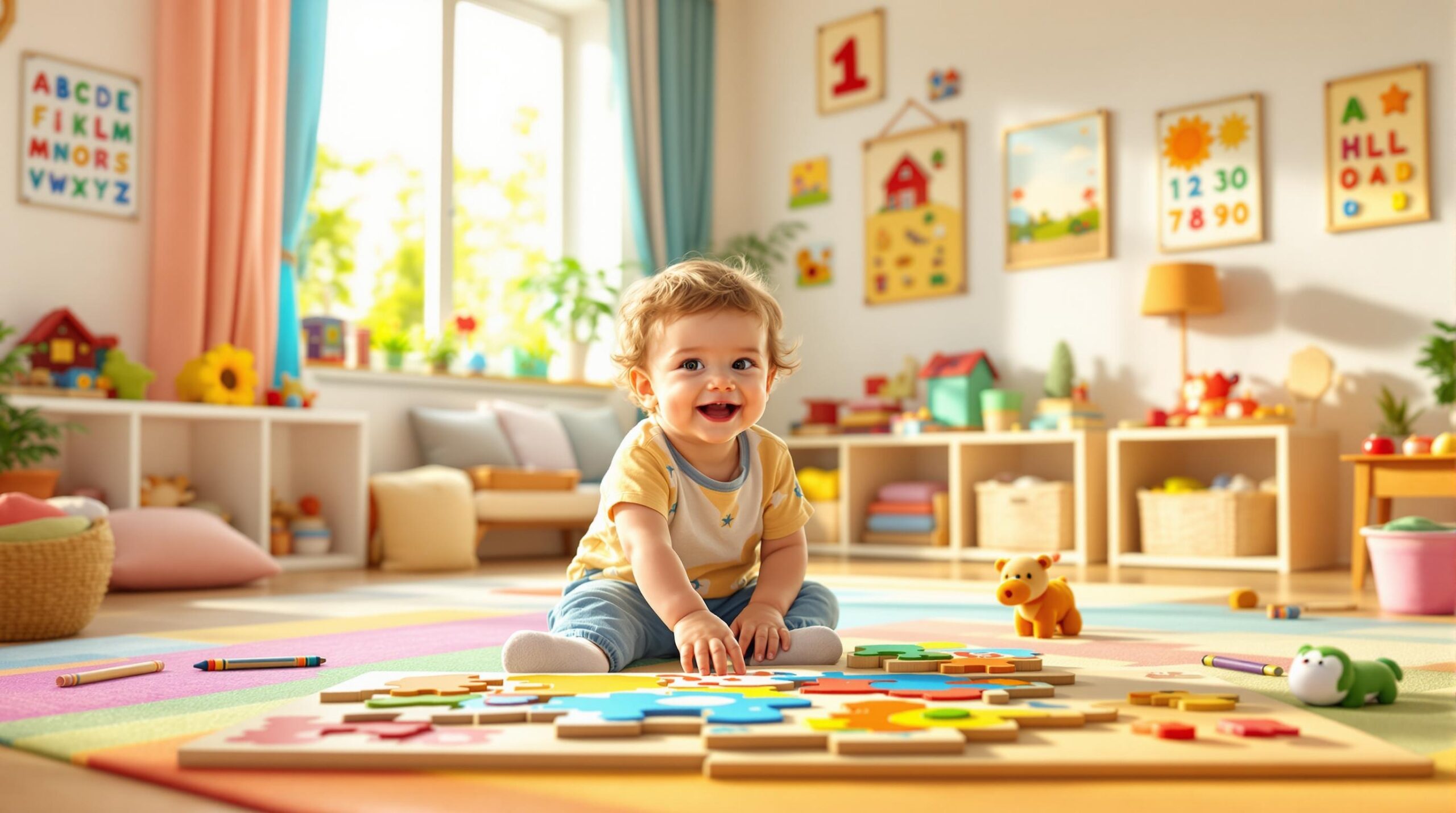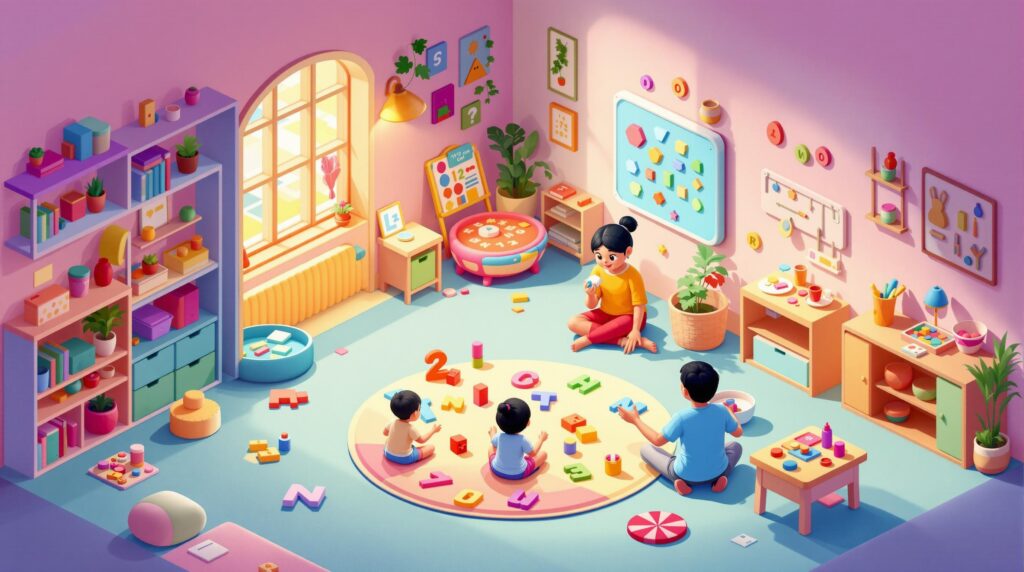Table of Contents
ToggleLearning should be an exciting adventure for toddlers, filled with discovery, joy, and engagement. As parents, we play a crucial role in shaping our little ones’ early educational experiences. By understanding their unique needs and creating an environment that nurtures their natural curiosity, we can set the stage for a lifetime of learning enthusiasm.
Unlocking Your Toddler’s Learning Potential: Understanding Their Unique Needs
Toddlers are inherently curious beings, constantly exploring their world through sensory experiences and movements. This active learning approach is fundamental to their development and forms the foundation of their educational journey.
During this stage, known as the preoperational stage of cognitive development, toddlers begin to engage in symbolic play and use language to represent objects and ideas. This period is crucial for developing their imagination and abstract thinking skills.
It’s essential to recognize the diverse cultures and experiences that shape each child’s learning journey. By incorporating culturally diverse content into our teaching methods, we can create a more inclusive and relatable learning environment for all toddlers.
While 82% of American adults possess ample literacy skills, it’s important to note that nearly one-fifth have limited literacy. This statistic underscores the importance of early childhood education in fostering strong literacy foundations.

Creating an Engaging Learning Environment for Your Little Explorer
To foster a love for learning in toddlers, it’s crucial to design spaces that stimulate exploration and engagement. Here’s how you can create an environment that sparks curiosity and promotes learning:
Stimulating Sensory Experiences
Toddlers learn best through their senses. Incorporate a variety of textures, colors, and sounds into their play area. For example, create a sensory bin filled with different materials like rice, beans, or water beads. This simple activity can teach new skills such as pouring, scooping, and identifying different textures.
Developing Fine Motor Skills
Use small toys and materials to help build hand-eye coordination and fine motor skills. Puzzles, building blocks, and threading activities are excellent for this purpose. These activities not only enhance physical dexterity but also promote problem-solving skills and spatial awareness.
Organizing Learning Materials
Arrange learning materials in clear, accessible sections. Use open shelves or labeled bins to store toys and books. This organization helps toddlers develop a sense of order and independence as they learn to choose and put away their own materials.
Incorporating Visual and Auditory Elements
When introducing new concepts, use visual aids like pictures, charts, or real objects. Pair these with simple explanations using a clear, engaging tone. For auditory learners, incorporate songs, rhymes, and storytelling into your learning activities.
Creating Comfortable Reading Spaces
Design a cozy reading nook with soft cushions and good lighting. Stock it with a variety of age-appropriate books, including touch-and-feel books, lift-the-flap books, and picture books. This inviting space will encourage a love for reading and storytelling.
Tailoring Activities to Your Toddler’s Developmental Milestones
Understanding and responding to your toddler’s developmental milestones is key to creating engaging learning experiences. Here’s how you can align your activities with their growing abilities:
Social and Emotional Development
Toddlers are learning to recognize and respond to names, distinguish emotions, and engage in social play. Encourage these skills through activities like:
- Mirror play: Help them identify and name facial expressions
- Pretend play: Set up a toy kitchen or doctor’s kit to practice social scenarios
- Group activities: Organize playdates or join parent-toddler classes to foster social interaction
Cognitive Development
At this stage, toddlers are mastering the art of finding partially hidden objects and exploring with their hands and mouth. Boost their cognitive skills with:
- Hide-and-seek games with toys
- Simple puzzles and shape sorters
- Memory games using picture cards
Language Development
From babbling chains of consonants to using their voice to express joy and displeasure, language skills are rapidly developing. Enhance their linguistic abilities through:
- Reading aloud daily, pointing to pictures and asking questions
- Singing songs and reciting nursery rhymes
- Narrating your actions during daily routines
Physical Development
As toddlers progress from rolling and sitting to more advanced skills like hopping and standing on one foot, it’s important to provide activities that challenge their growing abilities:
- For younger toddlers: Provide safe spaces for crawling and cruising
- For older toddlers: Set up obstacle courses or dance parties to practice gross motor skills
- Offer opportunities for climbing, jumping, and balancing
Incorporating Positive Parenting Principles for Holistic Learning
Creating a loving and supportive environment is crucial for encouraging emotional intelligence and healthy self-esteem in toddlers. By integrating positive parenting principles into your learning activities, you can foster a more holistic approach to early education.
Positive Reinforcement
Celebrate your toddler’s efforts and achievements, no matter how small. This doesn’t mean constant praise, but rather specific acknowledgment of their hard work and progress. For example, instead of saying “Good job!” try “I noticed how carefully you stacked those blocks. You didn’t give up even when they fell down!”
Positive Communication
Use clear, positive language when giving instructions or setting boundaries. Instead of saying “Don’t run,” try “Please walk slowly.” This approach helps toddlers understand what behavior is expected and reduces confusion.
Empathy and Emotional Regulation
Help your toddler identify and manage their emotions by naming feelings and offering comfort. When they’re frustrated with a puzzle, you might say, “I see you’re feeling frustrated. It’s okay to take a break and try again later.” This supports their emotional development and teaches healthy coping strategies.
Encouraging Independence
Provide opportunities for your toddler to make age-appropriate choices and complete tasks independently. This might include selecting their own clothes or helping with simple chores. These experiences build confidence and a sense of autonomy.
Embracing Play-Based Learning
Play is the primary way toddlers learn about their world. By incorporating playful elements into your learning activities, you can make the process more engaging and effective.
Sensory Play
Engage multiple senses through activities like:
- Water play with cups, funnels, and sponges
- Playdough or kinetic sand for tactile exploration
- Nature walks to observe colors, textures, and sounds
Imaginative Play
Encourage creativity and imagination through activities like:
- Dress-up corners with various costumes
- Puppet shows or storytelling with stuffed animals
- Creating art with unconventional materials (e.g., painting with ice cubes)
Active Learning
Incorporate movement into learning activities:
- Letter hunts around the house
- Counting jumps or hops
- Acting out stories or songs
Leveraging Technology Wisely
While it’s important to limit screen time for toddlers, technology can be a valuable tool when used appropriately. Here are some guidelines for incorporating technology into your toddler’s learning:
Interactive Learning Apps
Choose high-quality, age-appropriate apps that encourage problem-solving and creativity. Look for apps that:
- Have clear learning objectives
- Offer parental controls
- Provide opportunities for interaction beyond tapping and swiping
Educational Videos
Select short, engaging videos that complement your learning activities. For example, watching a brief video about farm animals before a trip to a petting zoo can enhance the experience.
Digital Storytelling
Use e-books or storytelling apps to add an interactive element to reading time. Many digital stories offer features like highlighting words as they’re read, which can support early literacy skills.
Cultivating a Growth Mindset
Fostering a growth mindset in toddlers can set the stage for lifelong learning and resilience. Here’s how you can nurture this mindset:
Embracing Challenges
Encourage your toddler to tackle new challenges by:
- Offering age-appropriate puzzles or games that require problem-solving
- Celebrating their efforts, not just their successes
- Modeling persistence when faced with difficulties
Learning from Mistakes
Help your toddler see mistakes as opportunities for growth:
- Use positive language when they make errors (e.g., “Oops! Let’s try that again.”)
- Share stories of your own mistakes and what you learned from them
- Encourage them to find different solutions when their first attempt doesn’t work
Praising the Process
Focus on the effort and strategies your toddler uses, rather than innate abilities:
- Instead of “You’re so smart!” try “I love how hard you worked on that!”
- Ask questions about their process (e.g., “How did you figure that out?”)
- Encourage them to explain their thinking and problem-solving strategies
Conclusion: A Journey of Discovery
Making learning fun and engaging for toddlers is an exciting journey of discovery – for both you and your child. By understanding their unique needs, creating stimulating environments, and incorporating positive parenting principles, you can foster a love for learning that will serve your toddler well throughout their life.
Remember, every child is unique, and what works for one may not work for another. Be patient, stay flexible, and most importantly, enjoy this precious time of exploration and growth with your little one. The key is to keep learning playful, interactive, and tailored to your toddler’s interests and developmental stage.
As you embark on this educational adventure, consider exploring Montessori activities for toddlers, which offer a wealth of engaging, hands-on learning experiences. With creativity, patience, and a dash of fun, you can create a rich learning environment that will set the stage for your toddler’s lifelong love of learning.
Sources:
Consumer Education Websites: A Guide to Creating a Family-Friendly Experience
Major Theories of Child Development: Frameworks for Learning
Complete Guide to Developmental Milestones
National Institute of Child Health and Human Development (NICHD)
American Academy of Pediatrics (AAP)
U.S. Department of Education
Centers for Disease Control and Prevention (CDC)
National Association for the Education of Young Children (NAEYC)













This Post Has 2 Comments
Pingback: The Best Montessori Activities for Toddler Learning – GuideForKids
Pingback: The Power of a Growth Mindset: Fostering Resilience in Kids – GuideForKids
Comments are closed.